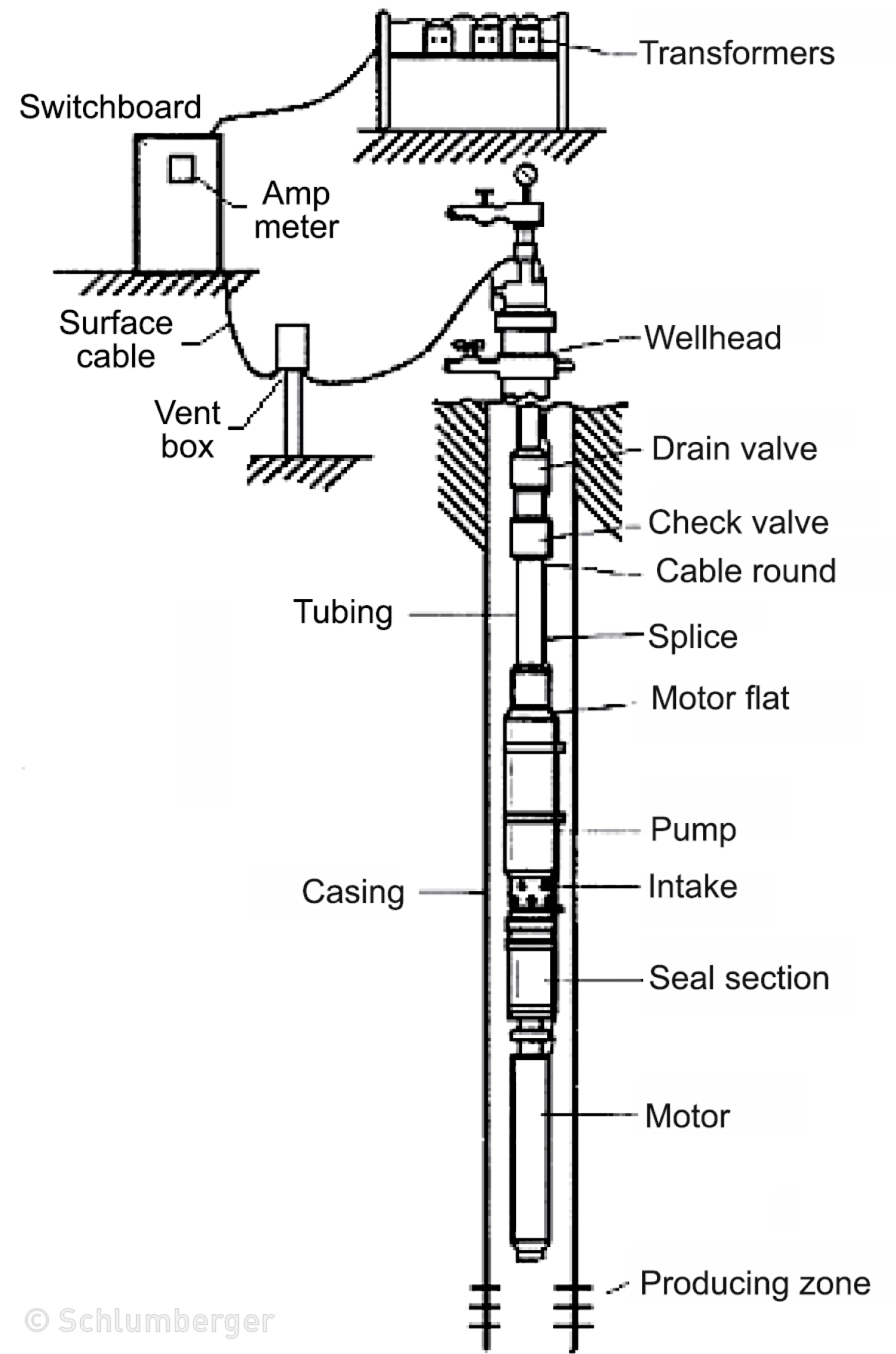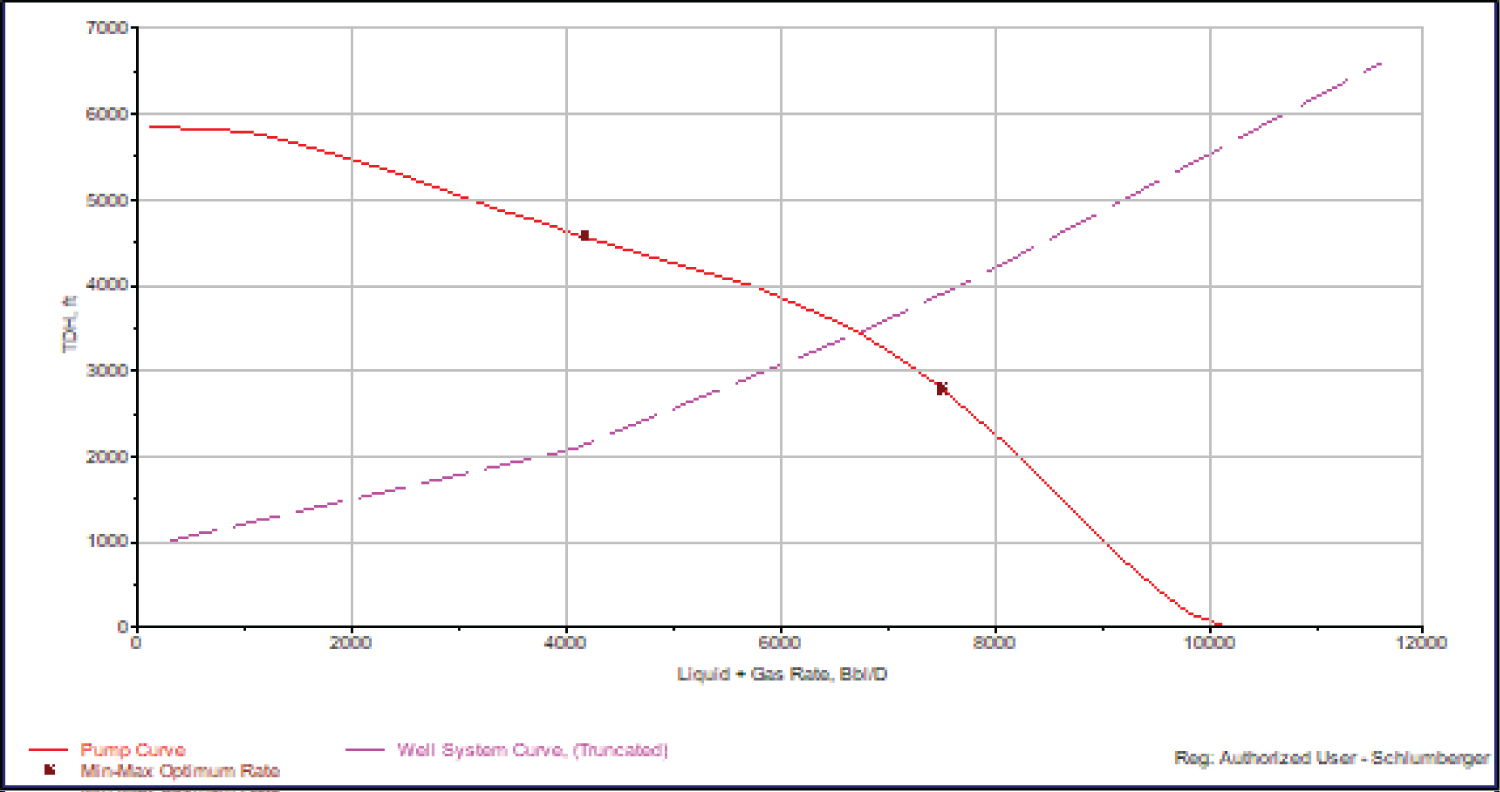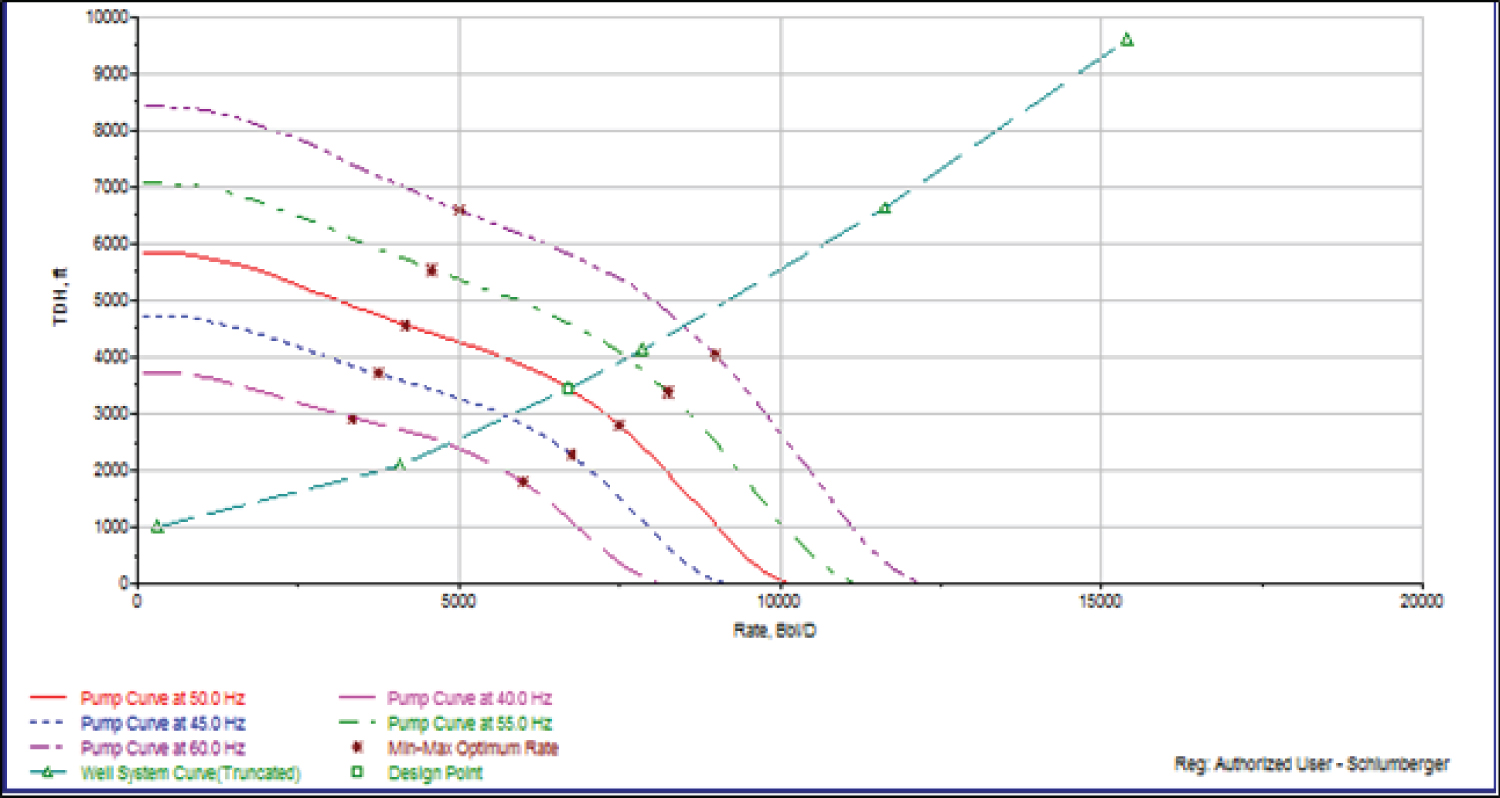
International Journal of Earth Science and Geophysics
(ISSN: 2631-5033)
Volume 7, Issue 2
Research Article
DOI: 10.35840/2631-5033/1849
Electric Submersible pump (ESP), A Better solution to Heavy Oil Production in Nigeria: Case Study of Enuma 3T in Niger Delta
Joseph Amieibibama* and Iwo George Papamie S
Table of Content
Figures

Figure 1: ESP system installed in a well (Courtesy of....
ESP system installed in a well (Courtesy of Schlumberger, (REDA) [9]).

Figure 2: Pump performance plot for Enuma 3T at design.....
Pump performance plot for Enuma 3T at design stage, showing the minimum and maximum optimum rates (as triangular markers) on the pump curve and the well system curve (magenta dashed line).

Figure 3: Pump performance curve at different....
Pump performance curve at different frequencies, showing the design point (as green square marker) and minimum-maximum oerating rates
Tables
Table 4: Regulatory Requirements for ESP Installation in Nigeria.
Table 5: Production and Operating conditions of Enuma 3T.
Table 6: Average annual net production history of Enuma 3T after installation of GN 7000 ESP model pump.
References
- Layrisse I (1999) Heavy-oil production in Venezuela: Historical recap and scenarios for the next century. Paper presented at the SPE International Symposium on Oilfield Chemistry, Houston, Texas, US.
- Batzle M, Zadler B, Hofmann R (2004) Heavy oils- seismic properties. SEG Int'l Exposition and 74th Annual Meeting Denver, Colorado, US.
- http://www.slb.com
- Meyer RF, Attanasi ED, Freeman PA (2007) Heavy oil and natural bitumen resources in geological basins of the world. US Department of the Interior, US Geological Survey.
- Attanasi ED, Meyer RF (2010) Natural bitumen and extra-heavy oil. In: Trinnaman J, Clarke A, Survey of Energy Resources. World Energy Council, 123-150.
- Szasz SE, Thomas GW (1964) Principles of heavy oil recovery. J of Canadian Petroleum Technology 04: 188-195.
- Hutchinson J (1985) Heavy oil and oil sands, heavy oil research in Saskatchewan. Journal of Canadian Petroleum Technology 24: 83.
- Little AD (2015) Trends and challenges in the heavy crude oil market. 4th Heavy Oil Working Group Bogota.
- https://petrowiki.spe.org/Electrical_submersible_pumps
- Modahi MH (2012) The importance of electrical submersible pumps (ESPs) in maximizing oil recovery. MSc Thesis at Dalhousie University, Halifax, Nova Scotia.
- Martinez J (2021) Introduction to artificial lift.
- Lea JF, Wells MR, Bearden JL, Wilson L, Shepler R (1994) Electrical submersible pumps: On and offshore problems and solutions. Paper presented at the International Petroleum Conference and Exhibition of Mexico, Veracruz, Mexico.
- Powers ML (1994) The depth constraint of electric submersible pumps. SPE Prod & Fac 9: 137-142.
- Eluagu RC, Ekwueme ST, Obibuike UJ (2020) Heavy oil production system optimisation using electrical submersible progressive cavity pumps (ESPCP) in the Niger Delta.International Journal of Oil, Gas and Coal Engineering 8: 40-46.
Author Details
Joseph Amieibibama* and Iwo George Papamie S
University of Port Harcourt, Nigerian Agip Oil Company, Nigeria
Corresponding author
Joseph Amieibibama, University of Port Harcourt, Nigerian Agip Oil Company, Nigeria
Accepted: August 07, 2021 | Published Online: August 09, 2021
Citation: Amieibibama J, Iwo GPS (2021) Electric Submersible pump (ESP), A Better solution to Heavy Oil Production in Nigeria: Case Study of Enuma 3T in Niger Delta. Int J Earth Sci Geophys 7:049
Copyright: © 2021 Amieibibama J, et al. This is an open-access article distributed under the terms of the Creative Commons Attribution License, which permits unrestricted use, distribution, and reproduction in any medium, provided the original author and source are credited.
Abstract
The use of electric submersible pumps (ESP) in producing conventional heavy oils from hydrocarbon reservoirs is gaining huge attention following the level of success rates recorded in fields where they have been deployed. Howbeit, due to their high failure rates, even at the inception of installation, had made many companies stay clear of its consideration as a means of improving recovery over other artificial oil recovery methods. This study evaluates the impact of the installation of GN 7000 ESP model pump designed to operate at 172 stages at 50 Hz on oil recovery at Enuma 3T well in Niger Delta. The pump was installed in 2003 and produced for about 10 years before its failure in September 2013. Upon installation, it produced on the average of about 8000 barrels of oil per day (bopd) of oil in the first year at a frequency of 52 Hz uninterrupted. The project payout within the first 6 months of installation, a remarkable achievement centered on adequate design and adherence to regulatory framework in the use of ESPs in Niger Delta, Nigeria.
Keywords
Heavy oil, ESP, Recovery, Viscosity
Introduction
The global energy demand is on steady rise and fossil fuels remain a major component of the energy mix. Although, there is a persistent call for cleaner and environmentally friendly source of energy, there are no current alternate sources of energy capable of completely replacing fossil fuels as a substitute for global energy supply. Globally, oil reserves are fast depleting, and the cost of new finds are increasing at astronomical rate following their locations and the depth of deposition. And even where the hydrocarbon resources are located at accessible and economically viable locations, the recovery of hydrocarbon has been limited by available technologies. Therefore, efficiently producing reserves using improved recovery methods for existing and proven reserves will enhance the sustainability of the oil and gas supply for commercial and industrial usage. Recently, attention has been drawn to the huge global deposits of heavy oils as a driver for the sustainability of the oil and gas supply, as well as an alternative energy source, because they constitute one of the largest reserves of previously unexploited fossil fuels on earth [1].
Heavy oils are formed from the alteration of conventional oils. In most cases, they are fundamentally different in chemical composition from conventional crude oils due to biodegradation. The light hydrocarbons in heavy oils are consumed by bacteria, leaving behind a complex mixture of organic compound with incredibly low gas-oil ratios [2]. Heavy oils have low API gravity in the range of 10-20 degrees, with viscosity greater than 100 cp and density between 920-1000 kg/m3. In some classifications like that from the World Petroleum Congress, heavy oils are defined as crude oils with API gravity somewhat slightly higher than 20° API but below 22.3° API [3]. Heavy oil can be classified as conventional and unconventional resource. The conventional heavy oils are those whose API gravity is between 10°-20° API inclusive and a viscosity greater than 100 cp [4]; which can be produced using some conventional recovery mechanisms whereas the unconventional heavy oils are the natural bitumen and extra-heavy oils, which are the remnants of very large volumes of conventional oils that have been generated and degraded, principally by bacterial action [5]. The focus of this paper is on the recovery of conventional heavy oil using ESP: A case study of Enuma 3T well in Niger Delta.
Global deposits of heavy oil
It is estimated that about 3,396 billion barrels originally oil in place (OIIP) heavy oil deposits exist worldwide with 30 billion barrels of prospective additional heavy oil [4]. The largest known deposit of heavy oils occurs in three regions: North America (651 billion barrels); South America (1127 billion barrels); and the Middle East (971 billion barrels) respectively. These regions hold about 81% of the total recoverable heavy oil reserves in the world. In terms of deposits by country, Venezuela holds the largest deposits with 924.19 billion barrels, followed by United States of America with 198 billion barrels while Russian holds about 182 billion barrels, respectively. Table 1 shows the distribution of heavy oil reserves worldwide.
Heavy oil recovery processes
There are different methods used in recovering heavy oils. Some of these methods include dynamic recovery methods, steam-assisted gravity drainage (SAGD) and cyclic steam injection (Thermal) methods, gas injection, chemical method, and pumps. The choice of a given method depends on several factors amongst which are: The viscosity of the crude, the depth of deposition, the composition of the crude, impact on the environment, energy efficiency, economics, and technical difficulties.
Viscosity is a limiting factor for heavy oil recovery and because of high viscosities, recoveries are extremely low, fluid drives are inefficient and production rates are uneconomical [2,6]. Even at shallow depths (below 3000 ft), oil recoveries are less than 11% compared to 30% from conventional reservoirs [6]. In fact, it is estimated that less than two per cent of heavy oil resource is, at present, considered to be producible and of this, less than half remains [7]. The operating cost, energy consumption and the associated environmental impact also play major roles in selecting a given technology for heavy oil recovery. For instance, it has been reported that heavy oil development technology that provide higher recovery factors (e.g in situ combustion, steam flooding, cyclic steam stimulation (CSS) and mining) tend to have the greatest environmental impact and consume the most energy [8]. Consequently, to make heavy oil recovery competitive with conventional oil recovery methods, more efficient technologies with less environmental impacts are being developed and used. Some of these new technologies use steam assisted gravity drainage (SAGD) principles but apply solvent and alternative warming techniques to enhance the heavy oil recovery and improve the recovery factor [8]. Examples of these new technologies are shown in Table 2. Therefore, good candidate selection criteria must be adopted to optimally recover heavy crude oils.
Conventional heavy oils are best produced using artificial lift methods. There are several artificial lift methods currently in use. However, the choice of a given method depends on several factors ranging from depth of operation, operating volume, ability to handle solids etc.: including statutory regulatory frameworks in host countries. Table 3 shows the selection guidelines for frequently used artificial lift methods for oil production with ESP having a good capability of handling low API gravity crudes.
Description of Enuma 3T
Enuma 3T is situated in the swamp area of Bayelsa State, Niger Delta, Nigeria. The well was drilled in the period between February to March 2003 and completed single selective string in level and commingled level with electric submersible pump (ESP) and gravel pack (GP) on each level. The well was then put-on production in April 2003 on ESP with initial net oil rate of 6645 barrels of oil per day (bopd) and water-cut of 10%. In August 2006, flow test was conducted, and the result showed that the oil production rate (Qo) has increased to 7164 bopd with a flowing tubing head pressure (FTHP) of 626 psi and water-cut of 13% respectively. On 29th May 2013, the ESP pump failed, and the well was finally put-on natural flow until it was shut-in on the 10th of September 2013.
Why ESP in Enuma 3T?
Electrical submersible pumps (ESP's) are well suited for high-rate, high-water-cut light oils from medium to shallow depths. Adaptation to hot heavy oils included larger motors and pumps and modifications to the pump stages to handle higher-viscosity fluids [1]. ESP's improve flowing tubing head pressure (FTHP) by lowering the flowing bottom-hole pressure (FBHP) to nearly zero; improves production rate in many candidate wells and allows economic production of potential candidate wells at high water cuts. They are very helpful in mature assets where improvement in vertical lift performance of wells is critical and have great positive impact on the ultimate recovery recorded in selected candidate wells. A typical example of installed ESP in a well showing its primary components (a multi-staged centrifugal pump, three-phase induction motor, seal-chamber section, power cable and surface control) are shown Figure 1.
Although, the water-cut and API gravity in Enuma 3T is low, the viscosity is high to risk the installation of other artificial lift methods to ensure sustained production. Moreover, so many factors limit the application and operation of ESP's, among which is increasing depth [12]. As the depth increases, the ambient temperature and the produced fluid temperature also increases; both affects the motor cooling and thus the performance of the pump and the motor [13]. The depth of Enuma 3T is within acceptable operating depth (10,360.89 ft) of an ESP that would not require retrofitting special features on the ESP (above 15,000 ft) to enhance its performance and improve hydrocarbon production. Additionally, like other countries producing oil and gas, installation of ESPs in Nigeria must meet certain regulatory requirements before any company would be permitted to deploy it as shown in Table 4; The oil gravity of Enuma 3T is 19° API with an average fluid viscosity of 4.4 cp and Gas-oil-ratio (GOR) of 277 scf/bbl. Since the fluid properties of Enuma 3T are within the permissible range of operating ESPs in Nigeria as shown in Table 4; the installation of ESP to effectively produce Enuma 3T and to substantially reduce the residual oil reservoir becomes imperative.
Method/ESP Design for Enuma 3T
Enuma 3T has been shut-down for a considerable period of time because of its inability to flow even though it has a reservoir pressure of 3500 psi and temperature of 152 °F which are considered high enough to guarantee flow for typical conventional oil wells. The inability of the wellbore fluid to overcome the pressure losses in the production string gave rise to the deployment of GN 7000 ESP model pump designed to operate at 172 stages at 50 Hz to assist in the removal of accumulated wellbore fluids. The design Pump Intake Pressure was 3446 psi with a fluid velocity of 1.634 ft/sec while the expected fluid flow rate was 6000 bbls/d to lift a 53.808 lb/cuft liquid from the wellbore. The pump was designed to be placed at a depth of 3158 m (10,360.89 ft), 75m (246.06 ft) away from the top perforations. The design system plot for Enuma 3T is shown in Figure 2. From the design plot shown in Figure 2, the minimum and maximum operating rates for this pump is 4200 bbl/d and 7700 bbls/d while the optimum operating rate is 6800 bbls/d at a frequency of 50 Hz respectively.
Results and Discussions
Figure 3 is the pump performance curve showing the optimum operating windows of the pump at different frequencies. The design operating point (shown as the green square marker; the intersection between the pump curve (red line) at 50 Hz and the system curve (green line)) is the reference. The other frequencies where chosen below and above this point to understand the operating window for this pump. As can be seen in Figure 3, as the frequency increases, the pump capacity also increases. However, care must be taken to ensure that very high frequencies are avoided to prevent sudden pump failure. Therefore, at a given frequency, the pump should be made to operate at the optimum condition that will not result to any detrimental effects.
From Figure 3, the minimum and maximum frequencies considered in this investigation are 40 and 60 Hz and their minimum and maximum operating rates at these frequencies are 3700 and 6000 bbl/d, and 5000 and 8800 bbl/d respectively. The operating points for each frequency (the point of intersection of the performance plots) are 4900 bbl/d for 40 Hz and 8000 bbl/d. Hence, the higher the frequency, the more fluid is produced from the wellbore across the production string and the lower the frequency, the lower the production rate. Typical production and operating conditions after the installation of ESP in Enuma 3T between 22 June 2003 and 06 December 2003 at a frequency of approximately 52 Hz is shown in Table 5. Table 5 shows that on the average, about 8000 bbl/d of net oil was produced along with about 0.800 MMscfd of gas with trace amounts of water production per day (BS&W is below 35%); a remarkable improvement from zero production due to overdue shutdown. Subsequent annual net production history for ten years after installation is shown in Table 6.
Economic Evaluation of Enuma 3T Well ESP Installation
Enuma 3T was completed in May 2003. The installation of ESP at Enuma 3T took about 165 Rig days to complete. The rig cost per day circa $70,000 while the cost of the full assembly of the ESP was $1,000,000. Other miscellaneous cost was about $350,000 while the approximate cost of operation for 5 years is $5,000,000. Hence, the total cost for the period of 5 yrs of operation is about $17,900,000.
Enuma 3T produced 8,000 bopd for the first one year without interruptions. The average cost of crude oil as at installation was assumed to be $28/bbl. The field produced traces of water while the average rate of gas production was 0.8 MMMscfd for the first year. Hence, income for the first 6 months of production was about $40,992,000. This result is consistent with similar investigations where the use of gas lift and electric submersible pump was compared in the production of heavy oil in Niger Delta; and the economic advantage of ESP surpassed that of gas lift significantly [14].
Conclusions
Production of heavy oil generally poses a greater challenge compared to conventional oil. However, using a reliable candidate selection criteria, conventional heavy oils can be effectively and efficiently produced with minimal risks. The installation of the right ESP in Enuma 3T as demonstrated in this paper that ESPs has the potential of reducing the residual oil saturations in heavy oil reservoirs. More importantly, compared to other heavy oil recovery methods, ESP is less energy intensive in application to produce heavy oil and environmentally friendly to be considered as one of the best alternatives in producing conventional heavy oil reservoirs globally.

